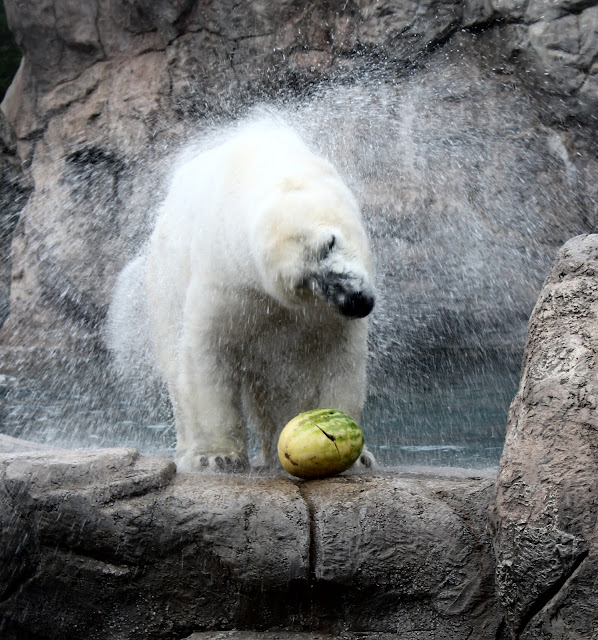 |
| Qannik enjoys the misting fan. |
 |
| Qannik and her tub of ice. |
 |
| Lee roamed the large enclosure, munching on grass. |
Arctic Sea Ice Day, held every year on July 15, was created by Polar Bears International to bring attention to the crisis of accelerating loss of Arctic sea ice.
 |
| Lee |
Many zoos, including the Louisville Zoo, use the occasion to educate the public about the need for sea ice in cooling the planet, why it is important for arctic wildlife, and steps we can take to help the environment, such as turning the lights off, setting the thermostat higher in summer and lower in winter, and diving more efficient vehicles.
It is a day when visitors to the Louisville Zoo can most likely see both polar bears who live there. During the rest of the year, the two polar bears in Louisville are rotated through two exhibit areas, taking turns with three grizzly bears, so there are times when you won't see a polar bear at all. But on Arctic Sea Ice Day, the spotlight is on the polar bears, so it is a great opportunity to see both Lee and Qannik.
 |
| My polar bear friend Debbie takes a photo of "wild child" Qannik. |
Qannik was in Polar Bear Alley, cooling off in a spot in the center where a strategically placed fan blew a refreshing mist down from the ceiling, She loved it. There was also big tub of ice for her playtime enjoyment.
 |
| A chunk of token "sea ice" for Qannik. |
Some chunks of ice that the keepers had frozen in pails were distributed throughout in both enclosures.
Qannik was born in a den in an Alaskan oil field in January of 2011. She got separated from her mother and sister in a blizzard, and was rescued as an underweight 15 pound cub, recovered at the Alaska Zoo, and came to Louisville in late June of 2011. She remains property of Fish and Wildlife so is not allowed to be part of the breeding program. |
| Qannik sits in the center of Polar Bear Alley, where a highly placed fan is blowing a cooling mist down upon her.. |
Qannik currently weighs 505 pounds.
 |
| That fan feels good. She can also go downstairs to her air conditioned bedroom. |
 |
| Polar Bear Alley, with Qannik at the center. The larger pool area, where Lee was spending the morning, is just across the way. |
The male polar bear at the Louisville Zoo is Lee, who was born in Rochester NY in 1999, and has lived in Lincoln Park in Chicago, Detroit, Denver, and most recently in Columbus where he fathered 2 year old Kulu (currently in Como Zoo in Minnesota). Lee came to Louisville in late 2020.
 |
| Handsome Lee in Louisville. |
Lee weighs in at 1040 pounds right now.
 |
| Lee was just swimming around, keeping cool and finding snacks. |
The docents at the Louisville Zoo invited curious visitors to touch a polar bear claw to feel the coarse hollow hairs of a bear.
 |
| A Louisville Zoo docent shows off the model of a polar bear skull, pointing out the space behind the fangs. |
Visitors could also examin a resin model of a polar bear skull, and see how the open jaws have a space that is just the right size for a seal head, to grab and hold it.
 |
| Arki's paw print |
Sea ice is the foundation for the ecosystem of marine life, the food chain that includes plankton, fish, seals, beluga whales, walrus, polar bears and everything in between.
Polar bears hunt mainly on the ice, especially ringed seals and bearded seals. Without the ice, there will be fewer seals. And the polar bears are not agile enough to catch their dinner in the water. With less food for the polar bears, there will be fewer cubs. The loss of sea ice is devastating to the polar bear population.
The loss of sea ice also drives the polar bears to human communities, where they rummage through the garbage and roam the streets in search of food, bringing the bears into conflict with humans. It is dangerous for the bears and the humans.
Since the Arctic, which serves as the "air conditioner" for the rest of the planet, is warming and losing sea ice, we are now seeing temperatures rise for the rest of us as well, with drought, wildfires, stronger storms and flooding as a result. Currently, parts of the US and Europe are suffering through deadly heatwaves and devastating wildfires.
 |
| Lee imitates and iceberg, under a See Ice Day sign. |
 |
| Lee captures retrieves some lettuce. Yes, polar bears like fruits and vegetables. |


















































